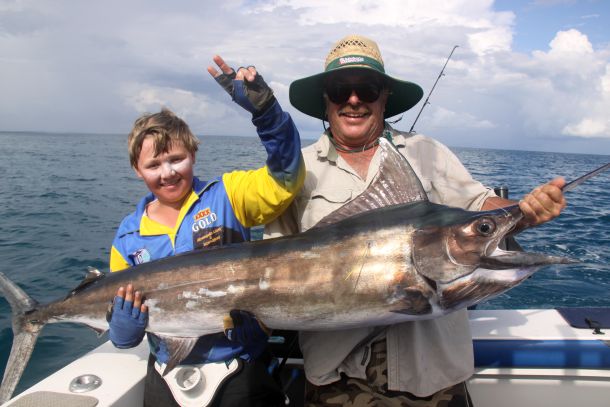BLACK marlin (recently reclassified as Istiompax indica, after formerly being known as Makaira indica) are considered by many authorities to be amongst the world’s premiere game fish. They certainly have size on their side, with the all tackle world record black marlin weighing in at 1560lb (707.6kg) taken by Alfred Glassell way back in 1953 off Cabo Blanco, Peru. Experienced skippers have reported seeing, and sometimes becoming connected to, black marlin that were probably even larger than Glassell’s catch, perhaps even approaching the size of some of the biggest blue marlin (Makaira nigricans). The latter have been caught on rod and reel up to 1805lb (819kg) and are known to grow to at least 900kg and possibly over a tonne, based on commercial catches of fish over this size.
Genetic evidence suggests that black marlin are more closely related to striped/white marlin than blue marlin, the latter being more closely related to sailfish. Compared to other marlin, black marlin are more solidly built with a relatively short bill and a lower, rounded dorsal fin. Black marlin can also be easily distinguished from other marlins as they are the only marlin that have rigid pectoral fins that cannot be folded flat against the body.
This oceanic pelagic species is distributed throughout the tropical Indian and Pacific Oceans and is found in surface waters above the thermocline at temperatures from 15 to 30°C. Black marlin migrate huge distances and relatively small tagged fish have been recaptured after travelling over 8000 km. Occasionally they will enter temperate waters, and small numbers sometimes stray into the Atlantic Ocean by way of the Cape of Good Hope, although the existence of Atlantic breeding stocks is unlikely. Despite their oceanic environment, large back marlin can sometimes be encountered very close to land, particularly near offshore islands and coral reefs, while juveniles commonly range closer inshore and can even be caught by landbased game anglers at specific locations when conditions are right.
Like other billfish, black marlin are apex predators that feed mostly on small tunas, but also other fishes, squids, cuttlefishes, octopods, and even large crustaceans. What is defined as “smaller fish” is relative, especially when you consider that large marlin over 500kg have been found with tuna over 50kg in their stomachs. Research off Australia’s east coast suggests that catchability of black marlin increases around the full moon and the week afterwards as its prey species move deeper out of the surface layers, forcing the marlin to forage over a wider area.
Black marlin grow very rapidly. Juveniles reach around 15kg in their first year, 50kg in their third year, and given sufficient food supply, a “grander” female black around 450kg (1000 lb) is possibly as little as 10-12 years old. Males and females are indistinguishable externally, but females attain a much larger size with males seldom growing more than 2.7 metres long and 200kg. Marlin do not change sex like some other fishes, but sex ratios vary with area and season, suggesting that movements of male and female black marlins may differ. Age at first maturity is not known exactly, but from Taiwanese data the length of males at first maturity is around 140cm (approximately 2 years old), for females around 230cm (4-5 years old).
Known spawning areas for black marlin, based on the presence of larvae and juveniles, are restricted to warmer tropical areas when water temperatures are around 27-28°C. Spawning occurs at specific times in specific regions in the western North Pacific, in the Indian Ocean on the northwest shelf off Exmouth and, most famously, in the Coral Sea off the Great Barrier Reef near Cairns during October and November. Here suspected pre-spawning behaviour has been observed with “grander” females being closely followed by several smaller male fish. Egg counts from ripe female black marlin can exceed 40 million per fish.

















